|
H
E A V Y C R U I S E R S
K E N T C L A S S
County
classes
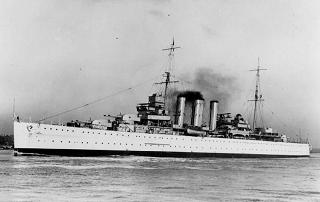
HMS
Kent (NavyPhotos)
G e n e r a l I n f o
r m a t i o n
This
Class of ship displaced 10,000 tons and were
designed by Sir Tennyson D'Eyncourt a renowned
Admiralty naval constructor. They proved superior in
operational conditions compared with foreign
cruisers of similar build. Their accommodation and
habitability was superior to that of previous
British cruisers. More importantly they could
sustain their designed speed indefinitely in all
weathers without exceeding designed power. During
WW2 their high endurance made them ideal ships for
patrol in distant waters at a time when fuelling at
sea was not practiced. In addition structural design
ensured good strength and protection of vital areas.
KENT
Class cruisers were armed with eight 8in guns in
twin turrets for surface targets and four single 4in
mountings as well as smaller weapons for
anti-aircraft defence. Originally they were fitted
with two quadruple Torpedo Tube mountings but these
were removed later. The 8in mountings had a very
high rate of fire and could be elevated to over 65
degrees. Facilities for carrying aircraft with a
hangar were added after build although removed
during WW2 in most ships when war experience showed
them of limited value.
The
overall length of the Class varied at about 630
feet, a beam of and a minimum draught of 16 feet and
3 inches Four propellers driven by steam turbines
with shaft horsepower of 80,000 produced a speed of
32.5 knots in service. Deck armour protection was
provided as well as for the machinery compartments,
steering gear, magazines and gunnery equipment.
Protection by external bulges was provided against
torpedo attack.. The original Complement of 680
significantly increased after 1939 due to addition
of new armament and radar equipment.
The
changes made during pre-war refits included
increasing the height of the funnels, the provision
of aircraft facilities (See above) and replacement
of the 4in single AA guns by twin mountings. Armour
protection was added at water line over the
machinery spaces. Close range anti-aircraft armament
was progressively increased during refits after
1939. Radar outfits for aircraft warning and
fire-control of main armament was also fitted when
it became available.
Without
exception all
KENT
Class cruisers (including HMS
BERWICK),
made notable contributions to winning the war at
sea. They were particularly effective in the trade
defence role where their long endurance qualities
proved their value. HMS
CORNWALL
was the only ship of the Class not to survive the
war. Of the remainder only one, HMS
CUMBERLAND,
remained in service after 1948.
Royal
Australian Navy
Two
ships of this Class were ordered by the Australian
Government in 1924 and a third was transferred in
1943 to replace a War Loss. The pre-war changes made
in the first 2 ships were as for the RN builds.
These included the provision of aircraft facilities
and the replacement of single 4in secondary armament
by twin mountings. Wartime changes were similar in
the ships which survived the war.
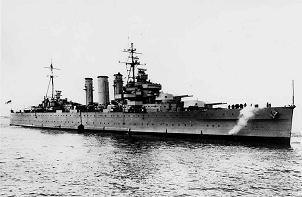
HMAS
Australia (Navy Photos)
HMAS
AUSTRALIA
- Modernised 1938-39 and refitted in Liverpool in
1940 when torpedo tubes were removed and AA armament
increased. This ship survived WW2 and one of the
after 8in mountings (X) was removed during a post
war refit.
HMAS
CANBERRA
- During a refit in 1941 additional AA armament was
fitted. This ships was lost in August 1942 (See
Chronology).
HMAS
SHROPSHIRE
- Transferred to replace HMAS CANBERRA. During
wartime refits the AA armament was improved and twin
4in mountings were fitted. Aircraft facilities were
removed prior to transfer and after 1945 torpedo
torpedo tubes were removed and twin 20mm and 40mm
Bofor mountings fitted to replace the single 20mn
mountings.
L
O N D O N C L A S S
County
classes
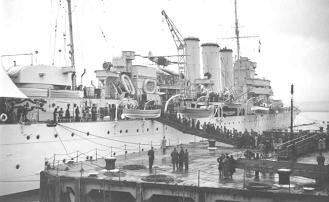
HMS
London (NP/Mark Teadham)
General
Information
This
Class of ships -
DEVONSHIRE,
LONDON,
SHROPSHIRE,
SUSSEX
-
displaced
9,850 tons and were designed by Sir William J Berry
of the Admiralty Naval Construction Department. Like
the KENT Class they proved to be superior under
operational conditions compared with foreign
cruisers of similar build. In particular their
accommodation arid habitability were much better
than those found in previous types of British
cruisers. More importantly these ships were able to
sustain their designed speed indefinitely in all
weathers without exceeding their designed power.
During
WW2 their high endurance made them ideal ships for
patrol in distant waters at a time when refuelling
at sea was not practised .In addition their
structural design was very strong and provided
protection for vital areas.
LONDON
Class cruisers were armed with eight 8in guns in
twin turrets for engagement of surface targets. Four
single 4in mountings and smaller weapons were fitted
to give anti-aircraft defence. The two quadruple
Torpedo Tube mountings also provided on build were
not removed later unlike those in the KENT Class
which were taken out. The 8in mountings had a very
high rate of fire and could be elevated to over 65
degrees. An aircraft with a maintenance hangar were
added after build and were retained in HMS
DEVONSHIRE although removed in other ships when war
experience had shown these facilities had only a
limited value.
The
overall length of the Class varied at about 630
feet, a beam of 68 feet 3 inches arid a minimum
draught of 17 feet at standard displacement. Four
propellers driven by steam turbines with shaft
horsepower of 80,000 produced a speed of 32 knots in
service. Deck armour protection was provided as well
as for machinery compartments, steering gear and
gunnery equipment. Internal bulges gave the hull
protection against torpedoes. The original.
Complement was 650 but this increased to over 800
after 1939.
The
changes made during Pre-war refits included the
provision of aircraft facilities (See above) and
replacement of 4in single AA guns by twin mountings
(Only two in some ships. Extensive improvements to
AA protection were made progressively after 1941.
Without
exception all LONDON Class cruisers made notable
contributions to winning the war at sea. They were
particularly effective in the trade defence role
where their long endurance qualities proved their
value. None of this Class was lost but only HMS
DEVONSHIRE was retained in service after 1950.
N
O R F O L K C L
A S S
County
classes
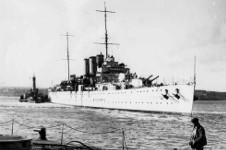
HMS Norfolk
(NavyPhotos)
General
Information
The
fifth Royal Navy ship to bear the name
NORFOLK
and ordered under the 1926 - 27 Programme with HMS
DORSETSHIRE.
Two others to be named NORTHUMBERLAND and SURREY
were also provided for but were subsequently
cancelled as an economy measure.
This
ship displaced 9,925 tons and was designed by Sir
William Berry, an Admiralty naval constructor. Like
the earlier KENT Class they proved superior in
operational conditions compared with foreign
cruisers of similar build. Their accommodation and
habitability was of a good standard compared with
British cruisers built before 1925. Distinguishing
features of the two ships are their Stern Walk,
their lower Bridge structure and the positions of
their AA armament abreast the funnels. During WW2
their high endurance made them ideal ships for
patrol in distant waters at a time when refuelling
at sea was not practiced. In addition the structural
design ensured good strength and protection of vital
areas.
NORFOLK-Class
cruisers were originally armed with eight 8in guns
in twin turrets for engaging surface targets and
four 4in single mountings as well as smaller weapons
for anti-aircraft defence. The AA armament was later
changed to four twin 4in mountings and one of the
8in turrets aft was removed. On build two quadruple
Torpedo Tube mountings were installed. but these
also were later removed. The 8in mountings had a
very high rate of fire and could be elevated to over
65 degrees. Facilities for carrying an aircraft
remained until war experience had shown these had
only a limited value.
The
overall .length of ships of this Class was 630 feet,
a beam of 66 feet 3 and a mean draught of 17 feet.
Four propellers driven by steam turbines with shaft
horsepower of 80,000 produced a speed of 33 knots in
service. Deck armour protection was provided for the
machinery compartments, steering gear and gunnery
equipment. The original Complement was 650 but this
increased to 710 after 1939.
HMS
NORFOLK was ordered from Faifields at Govan and was
laid down in July 1927. She was launched 12th
December 1928 and completed in June 1930.
During
wartime refits the AA armament was significantly
increased as more modem weapons became available.
Radar equipment including fire control units were
also added as shown in details of war service.
Both
ships of this Class gave notable service and were
particularly effective in the trade defence role in
which their long endurance proved their value. HMS
DORSETSHIRE was lost in action against Japanese
aircraft in the Indian Ocean on 5th April 1942. HMS
NORFOLK survived the war and became Flagship for
CinC Far East Station in December 1945 after a refit
at Devonport Dockyard. She came back to UK to
pay-off in May 1949 and was laid up in Reserve
at Falmouth until 1950 when sold for breaking- up at
Newport.
Y
O R K C L A S S
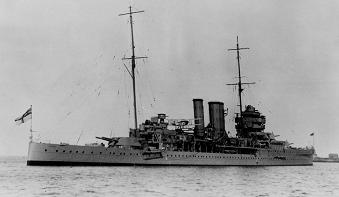
HMS
York (NavyPhotos)
G e n e r
a l I n f o r m a t i o n
The
eleventh Royal Navy ship to bear the name YORK and
ordered under the 1927-28 Programme as the first of
Class. The design was the first British attempt to
break away from the heavier 10,000 ton type of
cruiser. Bysacrificing one twin 8in gun turret a
saving of about 1,600 tons was achieved without
significantly reducing the overall capability
required. Although five ships of this type were
originally planned only two were built, the other
being cancelled for economic reasons.
Designed
by Sir William Berry, HMS
YORK
displaced 8,250 tons but HMS
EXETER
which was ordered a year later had a slightly wider
beam of 1 foot (58 ft) which thereby increased the
displacement to 8,390 tons. Their
accommodation and habitability was not as good as
that of the earlier cruisers of the LONDON and KENT
Classes. When first designed the ships were to have
had three funnels but in a subsequent change one was
eliminated by trunking the boiler up-takes for the
forward funnels. HMS YORK is easily distinguished by
her high funnels necessary to keep fumes away from
the bridge and which like the masts were raked. She
also had a larger bridge structure compared with HMS
EXETER which had straight funnels and a smaller more
compact bridge structure.
YORK
Class cruisers were armed with six 8in guns in twin
turrets for engagement of surface targets. Four
single 4in mountings and smaller weapons were fitted
to provide anti-aircraft defence. Two triple Torpedo
Tube mountings were installed instead of the
quadruple type previously found in cruisers, as the
space needed to train the quadruple mountings was
restricted. The original design allowed for two
seaplanes to be carried, one of which was to be
launched from a forward turret. However the strength
of the turret structure proved to be inadequate and
the catapult was never fitted. As a result only one
aircraft was carried and launched from the midship
catapult abaft the after funnel. A crane was fitted
for recovery of the seaplane.
The
overall length of the Class was 575 feet, a beam of
57 and a mean draught of 17 feet. Four propellers
driven by steam turbines with shaft horsepower of
80,000 produced a speed of 32 knots in service. Deck
and side armour protection was fitted as well as 3in
armour for the Gunnery Director and 1 1/2
inches over steering gear . The designed Complement
was 600 but this increased after 1939 when more
personnel were required for additional AA armament
and other war requirements.
Some
improvements were made In HMS YORK during a refit in
1931 when the upper deck plating was extended
farther aft to the forward funnel. This provided
additional accommodation and also improved
habitability in rough weather. There were no other
major changes during war service.
Both
ships were lost during WW2. HMS YORK was sunk by air
attacks at Suda Bay in Crete after being seriously
damaged by an Italian explosive motor boat . HMS
EXETER was lost in a valiant action with Japanese
warships during the defence of the Dutch East Indies
in 1941 . She is also renowned for her part in the
action with German battleship ADMIRAL GRAF SPEE off
the Plate estuary in 1939.
L
I G H T C R U I S E R S
C - C L A S S E S
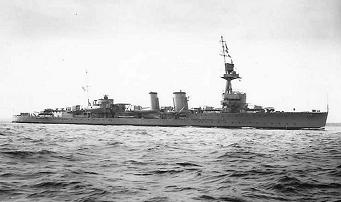
HMS
Caledon (NP/Paul Simpson)
G
e n e r a l I n f o r m a t
i o n
In
all fourteen ships of this type were ordered under
Emergency War Programmes between 1915 and 1918. They
were a development of the 1912 ARETHUSA Class. The
first orders for three were followed by a second
batch of five the next year. Orders for a third
batch, also of five ships were placed in 1917. One
ship of the first batch, HMS CASSANDRA was
lost
in 1918 after being mined in the Baltic Sea.
They
were built to reinforce the Royal Navy's strength in
this type of warship. Ships in the second and third
batches were designed with a Trawler bow to reduce
the effect of the sea in rough weather or when at
high speed. An aircraft hangar was fitted in HMS
CARLISLE and HMS CAPETOWN during build but removed
before 1938. Some of this Class were fitted for use
as Flagships and deployed before 1935 on foreign
stations.
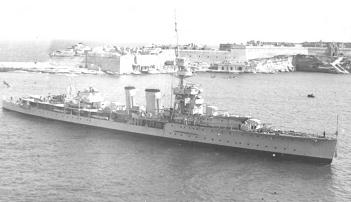
HMS Ceres (NP/Mark
Teadham)
As
part of the re-armament programme in 1935 two C
Class Cruisers were selected for conversion into
Anti-Aircraft Cruisers and were known as COVENTRY
Class. Before the outbreak of WW2 conversion of the
others was planned but only five more were
completed.
|
Name
|
Builder
|
Launch date
|
Remarks
|
|
CALEDON Class - 1915 Emergency War
Programme
|
|
CALEDON
|
Cammell Laird
|
25.11.16
|
Converted 1942 - 1943
|
|
CASSANDRA
|
Vickers
|
25-11.16
|
Lost in Baltic 12.1918.
|
|
CARADOC
|
Scotts
|
23.12.16
|
Not converted.
|
|
CALYPSO
|
Hawthorn Leslie
|
24. 1.18
|
Not converted.
|
|
CERES Class - 1916 Emergency War
Programme
|
|
CERES
|
John Brown
|
24. 3-17
|
Conversion cancelled 1939
|
|
CARDIFF
|
Fairfields
|
12. 1.17
|
Conversion cancelled 1939.
|
|
CURACOA
|
Harland & Wolff
|
5.5 17
|
Converted 1939 - 1940.
|
|
CURLEW
|
Vickers
|
5.7.17
|
Converted 1936 - 1937
|
|
COVENTRY
|
Swan Hunter
|
6.7.17
|
Converted 1935-
|
|
CARLISLE Class -1917 Emergency War
Programme
|
|
CARLISLE
|
Fairfields
|
9. 7-18
|
Converted 1939 - 1940.
|
|
CALCUTTA
|
Vickers
|
9. 7.18
|
Converted 1939 - 1940.
|
|
CAIRO
|
Cammell Laird
|
19.11.18
|
Converted 1939 - 1940
|
|
COLOMBO
|
Fairfields
|
18.12.19
|
Converted 1942 - 1943
|
|
CAPETOWN
|
Cammell Laird
|
28. 6.19
|
Not converted.
|
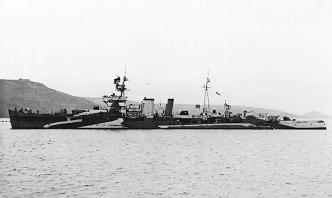
HMS
Carlisle (NavyPhotos)
Particulars
(CALEDON Class as designed). Others similar
|
Displacement
|
4,180 tons on build.
|
|
Armament
|
5
- 6in; 2 - 3in; smaller AA weapons; 1 Twin
21in Torpedo Tubes.
|
|
Dimensions
|
Length 150 feet: Beam : 12 feet 9 inches.
Draught : 11 feet 3 inches.
|
|
Machinery
|
2
Shafts : Steam turbines 10,000 SHP : Speed
29 knots.
|
|
Endurance
|
6,000 miles at 12 knots; 1,300 miles at
maximum continuous speed.
|
|
Armour
|
Protection was provided on the decks and
for the gunnery Director.
|
|
Complement
|
437
(Increased to 500 in converted ships
during WW2)
|
The
ships converted proved invaluable during WW2 and
they served with great distinction during the
Norwegian operations and later in the Mediterranean.
Six ships were lost and one damaged beyond repair.
|
Name
|
Date
|
Details
|
|
CURLEW
|
26.
5.40
|
By
aircraft bombs off Norway.
|
|
CALYPSO
|
12.
6.40
|
By
submarine torpedo off Crete.
|
|
CALCUTTA
|
1.
6.11
|
By
aircraft bombs off Crete.
|
|
CAIRO
|
12.
8.12
|
By
submarine torpedo off Bizerta.
|
|
COVENTRY
|
14.
9-42
|
By
aircraft bombs off Tobruk.
|
|
CURACOA
|
2.10.12
|
In
collision with rms QUEEN MARY.
|
|
CARLISLE
|
11.43
|
Declared Constructive Total Loss after
damage.
|
I M P R O V E D B I R M I N G H A
M o r H A W K I
N S C L A S S
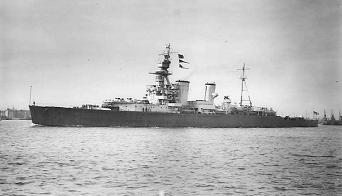
HMS
Frobisher (NP/Paul Simpson)
G
e n e r a l I n f o r m a t
i o n
Five
Light Cruisers of this Class were built. Later,
after WW1, they became known as HAWKINS Class. They
were ordered under War Emergency Programmes but were
not ready for service until after November 1918
|
Name
|
Builder
|
Launched
|
Remarks
|
|
EFFINGHAM
|
HM
Dockyard Portsmouth
|
8th
June 1921
|
Ran
aground off Norway and wrecked May 1940
|
|
FROBISHER
|
HM
Dockyard Devonport
|
20th
March 1920
|
Broken-up at Newport 1949
|
|
HAWKINS
|
HM
Dockyard Chatham
|
3rd
June 1916
|
Broken up at Dalmuir, 1947.
|
|
RALEIGH
|
Beardmore
|
28th
August 1919
|
Ran
aground off Labrador, August 1922.
|
|
VINDICTIVE
(Ex
CAVENDISH)
|
Harland and Wolff
|
17th
January 1918
|
Launched as CAVENDISH. Completed as an
Aircraft Carrier and renamed. Converted to
Cruiser 1923-5. Demilitarised for use as
Cadet Training Ship 1936-7. Converted to
Repair Ship 1940. Broken up at Blyth.1946.
|
These
ships displaced 9,750 tons as designed and were 605
feet long overall with a beam of 65 feet and a
draught of 17 feet 3 inches. By 1945 the two ships
still in an operational use had an increased
displacement due to changes of equipment fitted.
Their main armament as designed comprised seven
7-5in single mountings with twelve 2 Pdr guns. In
addition they carried six. 21in torpedo tubes, two
being submerged and 4 deck mounted. HMS HAWKINS was
the only ship in the Class completed with the
designed armament. Some armour protection was fitted
for sides, upper deck and over machinery and
steering gear. These ships also had external bulges
to give protection against torpedo hits.
Extensive
changes in the armament were made in all ships and
in 1939 after re-arming HMS HAWKINS had seven 7.5in
for surface engagements with four 4in single
mountings and four 2Pdr pom-pom guns for anti-
aircraft defence. Six 21in torpedo tubes were
fitted. During refits later in WW2 additional close
range AA guns and radar were installed.
The
propulsion machinery as designed provided 65,000
shaft horse power driving four shafts. It included 6
oil fired and two coal fired boilers. However HMS
HAWKINS was converted to full oil firing in 1929
when two boilers were removed. This reduced, the
shaft horsepower to 55,000 and speed from 30 knots
to 29 knots. Her endurance at full speed after this
change was 2,900 miles and at 10 knots 10,600 miles.
All
ships in this Class were designed to be used as
Flagships having a complement of over 700 but this
increased during WW2 in the two ships in service
after 1940 due to addition of radar and close range
AA guns.
HAWKINS
Class cruisers, being of WW1 design were unsuited to
the demands placed on the Royal Navy in WW2 except
in the trade defence role. The modernisation and
refit carried out during the 1930's did not include
the addition of adequate AA armament and their main
contribution was in trade defence, particularly in
the Indian Ocean.
It
is worth recording that two of this Class were
wrecked after running aground and that three were
specially altered for use as Cadet training ships.
L E A N D E R C L A S S
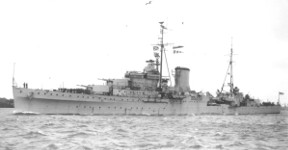
HMNZS
Leander (NP/Mark Teadham)
D
e t a i l s o
f C l a s s
|
Estimates
|
Name
|
Remarks
|
|
First Group (single funnel)
|
|
1929
|
LEANDER
|
Lead ship. Scrapped at Blyth 13/1/50
|
|
1930
|
ORION
|
Scrapped at Troon 19/7/49.
|
|
|
NEPTUNE
|
Lost in Mediterranean 19/12/41.
|
|
|
ACHILLES
|
At Battle of River Plate.
Transferred to India as DELHI on 1948
(Note : Serving with tine New Zealand
Division as HMS ACHILLES at the outbreak
of WW2 and integrated into the Royal New
Zealand Navy when it was established by
Order in Council in July 1941. She was
formally transferred on 1st October 1941
and then became HMNZS ACHILLES.)
|
|
1931
|
AJAX
|
At Battle of River Plate. Scrapped at
Newport 11/49.
|
|
Second Group (two funnels
|
|
|
AMPHION
|
Built for Royal Australian Navy. Renamed
HMAS
PERTH. Lost in action 1/3/42.
|
|
1932
|
HOBART
|
Built for Royal Australian Navy. (Ex
APOLLO) . Scrapped in Japan 1962
|
|
|
SYDNEY
|
Built for Royal Australian Navy.
Lost in action 19/11/41.
|
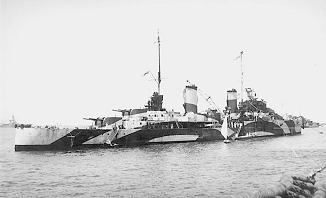
HMAS Perth (NP/Bruce
Constable)
This
Class of ship displaced about 7,000 and represented
a return to a moderate size compared with the
earlier 10,000 ton heavy cruisers. Their main
armament of 6 inch guns was of a new design using
the Auto-frettage system of barrel rifling instead
of being wire wound. These guns were mounted in twin
turrets which were believed to to be superior in
performance compared with the triple mountings used
in the German KOLN Class cruisers. The roomy turrets
allowed guns to elevate to 60 degrees.
In
addition to the four twin 6in mountings used for
engaging surface targets, LEANDER Class cruisers had
four single 4in guns and smaller weapons for
anti-aircraft defence. These ships were also fitted
with two quadruple 21 inch torpedo tube mountings.
Although
the design was criticised as being underarmed for
its size and considered vulnerable because of
adjacent boiler rooms their service in WW2 belied
these misgivings since they survived shell, torpedo
and bomb damage. The initial design also included
facilities for a seaplane and a catapult used for
its launch. A crane was provided for recovery of the
aircraft. During a refit in 1937, the single 4in AA
mountings were replaced by four twin mountings of a
modem design. Later during WW2 the aircraft
facilities were removed to enable the fitting of
more close-range anti-aircraft guns. Extensive
additions were made to the number of Close Range AA
weapons and several radar sets were fitted for
aircraft warning and surface warning as well as for
fire control of main and AA armament. Two ships of
the Class, HMS LEANDER and HMS ACHILLES, had one of
the after 6in turrets removed so as to save
top-weight when the additional AA weapons were
fitted.
The
overall length of this Class was about 554 feet with
a beam of 55 feet 8 inches and a draught of 16 feet
at standard
displacement. Four propellers driven by turbines
with shaft horsepower of 72,000 produced a speed of
32 knots in service. Design arrangements for
propulsion machinery in ships of Group 2 were
significantly changed by adoption of the Unit System
in which Boiler and Engine Rooms were separately
associated with drive for Inner or Outer propeller
shafts. This arrangement introduced use of two
funnels and enables these ships to be easily
identified. Four boilers were used as opposed to six
in Group 1 and layout of machinery compartments
differed. Upper deck layout differed with aircraft
catapult sited between the funnels, secondary
armament and torpedo tubes were re-position further
aft. The armour protection was provided for decks
and side as well as for the machinery compartments
and gunnery equipment. Complement as designed was
550 in peace and 715 in war, but it increased in WW2
due to fitting of additional equipment.
Three
of the Class had been broken-up by 1951 and the
fourth which survived WW2 was transferred to India.
She served with the Indian Navy until the mid
1970's.
A
R E T H U S A C L A S
S
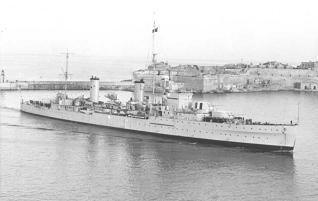
HMS
Arethusa (NP/Mark Teadham)
G
e n e r a l I n f o r m a t
i o n
This
Class was designed within Treaty limits and were
intended primarily for the defence of ocean trade
and to be easily produced in large numbers. Costs
were kept low by extensive use of welding and
provision of aluminium covered plywood for the
bulkheads of accommodation spaces. The cost of
building each ship was over £1.2M excluding items
supplied by Admiralty such as weapons and
communication equipment.
Four
ships were built to this basic design but the last
two (HMS PENELOPE and HMS AURORA) were fitted with
four twin 4 inch High Angle guns instead of single 4
inch mountings. These ships also had a gunnery
control director fitted for these anti-aircraft
mountings which was sited abaft the mainmast. The
searchlight in that position was placed aft of the
second funnel.
D
e t a i l s o
f C l a s s
|
Estimates
|
Name
|
Remarks
|
|
1931
|
ARETHUSA
|
Lead
ship. Broken up in 1950
|
|
1932
|
GALATEA
|
Sunk
off Alexandria on 11/12/41
|
|
1933
|
PENELOPE
|
Sunk
off Anzio 8/2/44.
|
|
1934
|
AURORA
|
Sold
to China as CHUNGKING in 1948.
|
This
Class of ship displaced about 5,270 tons and were
smaller than the earlier 7,000tons LEANDER Class.
Their main armament comprised six 6 inch guns
mounted in twin turrets for engaging surface
targets. As described above the AA defence was
improved in the last two ships which had 4 twin
mountings. Close range AA defence was further
implemented during WW2 following bitter experience
in Norway by the addition of 20mm Oerlikon guns. All
four ships carried two triple 21 inch torpedo tube
mountings fitted on the upper deck.
The
initial design also included aircraft facilities
with hangar and a catapult, except in HMS AURORA
which had additional superstructure amidships. A
crane was provided for recovery of the aircraft and
handling boats. The aircraft facilities were
removed during WW2 to allow the installation of acre
close-range AA guns.
The
overall length of this Class was 506 feet with a
beam of 51 feet and a draught of about 14 feet at
standard
displacement. Four propellers driven by turbines of
64,000 shaft horsepower produced a speed of 32 knots
in service. Armour protection was provided for decks
and sides including the machinery compartments and
turrets. The arrangements of machinery compartments
in the ARETHUSA Class differed from the earlier
LEANDER Class design. These four ships had two sets
of turbines and boilers fitted in two separate
compartments to prevent total flooding of the boiler
rooms In the event of damage in action or in
collision. As a result they had two funnels, unlike
the single funnelled LEANDERS. Another engineering
feature was the use of fluid flywheel transmission
forthe speedy transfer of power from the main
engines to cruising turbines.
As
designed the Complement was 550 in peace and 715 in
war, but this increased in WW2 due to fitting of
additional equipment such as radar and AA guns.
During
WW2 ARETHUSA Class cruisers served with distinction
both in Home waters in Norway and in the
Mediterranean for the defence of supply
convoys to Malta and the support of military
operations in North Africa. HMS AURORA served in
Home waters, including the Norwegian campaign before
going to the Mediterranean to join Force K for
operations against enemy supply convoys to North
Africa. She was twice badly damaged but survived the
war as shown in the Chronology. Some names of this
Class were again used for LEANDER Class Frigates
built after 1961.
S
O U T H A M P T O N O
R T O W N C L A S S E
S

HMS Southampton
(NP/Bruce constable)
G
e n e r a l I n f o r m a t i o n
Eight
SOUTHAMPTONS were constructed and all entered
service before the outbreak of war in September
1939. They were the British response to the American
SAVANNAH Class and Japanese MOGAMI Class cruisers of
a similar size and armament. The British ships had a
striking appearance easily recognised by their two
raked funnels which were a departure from the design
of earlier Classes of cruiser.
Ships
in this batch displaced 9,100 tons and were armed
with four triple 6 inch turrets for engaging surface
targets and four twin 4in gun mountings with several
other types of smaller guns for anti- aircraft
defence. Facilities were provided for carrying three
WALRUS seaplanes which were launched using an
athwartships catapult and recovered by a crane. The
basic design included a maintenance hangar.
Changes
were made to the armament of the Class including the
addition of several close close range AA guns and
the removal of X turret. The latter major alteration
was not implemented in HMS MANCHESTER because of her
premature loss. The overall length of the batch was
591 feet and 6 inches, a beam of 62 feet 8 inches
and a draught of 20 feet. Four propellers driven by
steam turbines with shaft horsepower of 82,500 gave
a speed of 32 knots. Armour protection was provided
for machinery compartments and for the main armament
turrets.
After
the outbreak of war radar was fitted for detection
of aircraft and also for fire control of both main
armament and anti-aircraft weapons. Improved outfits
were installed during refits and when ships were
modernised. The original Complement was 700 but this
increased very significantly during WW2 due to the
addition of more equipment.
Details of Ships
|
Programme
|
Name
|
Builder
|
Launched
|
Completed
|
Remarks
|
|
1933
|
SOUTHAMPTON
|
John
Brown
|
10.
3.36
|
6.
3.37
|
Ex
POLYPHEMUS. Lost 11. 1.41 in air attacks
|
|
|
NEWCASTLE
|
Vickers, Tyne
|
23
1.36
|
5.
3.37
|
Ex
MINOTAUR. Scrapped 8.59.
|
|
1934
|
SHEFFIELD
|
Vickers, Tyne
|
23.
7.36
|
25.
8.37
|
Scrapped 9.67.
|
|
|
BIRMINGHAM
|
Devonport Dyd.
|
1.
9.36
|
18.11.37
|
Scrapped 9.60.
|
|
|
GLASGOW
|
Scotts,Greenock
|
20.
6.36
|
8.
9.37
|
Scrapped 7.58.
|
|
1935
|
GLOUCESTER
|
Devonport Dyd.
|
19.10.37
|
31.
1.39
|
Lost
22.5.41 in air attack.
|
|
|
LIVERPOOL
|
Fairfield, Govan
|
24.
3.37
|
25.10.38
|
Scrapped 7.58.
|
|
|
MANCHESTER
|
Hawthorn Leslie
|
12.
4.37
|
4.
8.38
|
Lost
13. 8.42 in air attack.
|
Three
ships of the Class HMS SOUTHAMPTON, HMS MANCHESTER
and HMS GLOUCESTER were lost in action in the
Mediterranean. Four of the surviving ships served
for ten years after 1945 and the other cruiser of
the Class, HMS LIVERPOOL Paid-off in 1953. Between
1950 and 1952 HMS NEWCASTLE and HMS BIRMINGHAM
underwent major reconstruction including the fit of
air conditioning in some compartments. Structural
changes in these two ships included a new design
lattice foremast and a rounded Bridge structure
which make them easy to identify. The excellence of
the design arrangements is proved by the fact that
it was followed in the later Classes of cruisers and
by their excellent record of war service.
Two
ships of an Improved SOUTHAMPTON Class were ordered
in the 1936 Build Programme and named:-HMS EDINBURGH
and HMS BELFAST.
I M P R O V E D S O U T H A
M P T O N O
R E D I N B U R G
H C L A S S
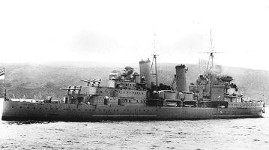
HMS
Edinburgh (NavyPhotos)
General Information
Two
ships of this type were ordered on 15th August 1936
and were larger than those of the SOUTHAMPTON Class
ordered
under the 1933, 1934 and 1935 Estimates. The
Improved SOUTHAMPTON Class comprised :
HMS
BELFAST
from Harland and Wolff, Belfast.
HMS
EDINBURGH
from Swan Hunter, Newcastle.
Both
ships were completed before the outbreak of war in
September 1939- The earlier SOUTHAMPTON Class heavy
cruisers were designed as the British response to
American SAVANNAH Class and Japanese MOGAMI Class of
a similar size and armament. Both Improved
SOUTHAMPTON Class cruisers had their two slightly
raked funnels in a position much nearer the stem,
the second being sited abaft the mainmast. This
feature makes them easily distinguished from any
other British cruiser.
Their
Standard Displacement was 11,580 tons (14,930 tons
at Full load). They had a main armament of four
triple 6 inch gun turrets for engaging surface
targets and had four twin 4in gun mountings with
several other smaller anti- aircraft weapons. In
addition they were fitted with two sets of triple
torpedo tubes mounted amidships on either beam on
the upper deck for attacks on surface ships. Three
WALRUS type seaplanes launched using an athwartships
catapult and recovered using a crane were also
provided. A hangar was included in the original
design but the requirement to carry aircraft in
cruisers was changed during WW2 as a matter of
policy and this facility was removed.
The
overall length of the batch was 613 feet and 6
inches, beam of 63 feet 4 inches and a draught
of 17 feet 3 inches. Four propellers driven by
steam turbines having a shaft horsepower of 82,000
produced a speed of 32 knots. The endurance at 14
knots was 8,000 miles. Improved armour protection
was provided in these two ships, compared with the
earlier SOUTHAMPTON Class and covered sides,
machinery compartments and the main armament.
The
original Complement was 710 but this increased
significantly after 1939 due to the fitting of radar
outfits and additional close range AA weapons. After
their completion and following the extensive
structural damage caused when HMS BELFAST detonated
a magnetic mine in December 1939, the design of both
ships had to be extensively reviewed. As a result it
was decided to provide more strengthening. War
experience with both ships showed that their design
arrangement were not satisfactory comparedwith the
original SOUTHAMPTON Class.
HMS
EDINBURGH had a very active career in every sense
and saw service in Home waters and in the
Mediterranean. Whilst returning from Murmansk with a
cargo of bullion she was torpedoed soon after
joining the escort for a returning Russian Convoy.
Extensive damage was caused including loss of
rudder. Despite the efforts made to return to
Murmansk these were frustrated by an attack by
German destroyers. Although one was sunk by HMS
EDINURGH after a surface gun action the ship was
again hit by 2 torpedoes fired by one of the enemy
destroyers and sustained further damage that proved
beyond control. HMS EDINBURGH had therefore to be
abandoned and was sunk by our own forces.
HMS
BELFAST was out of comnission for many months after
detonating a magnetic mine in 1939 but after
rejoining the Fleet in 1943 saw extensive service
and took part in the Battle of North Cape in
December when the German battleship SCHARNHORST was
sunk in an action with the Hone Fleet. As shown in
the Chronology she remained in service after WW2 and
is still afloat in the Pool of London as Museum
ship.
D
I D O C L A S S
A N T I - A I R C
R A FT C R U I S E R S
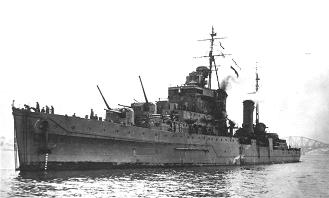
HMS
Dido (NavyPhotos)
G
e n e r a l I n f o r
ma t i o n
This
type of cruiser was developed from the earlier
ARETHUSA Class and was intended to improve the
anti-aircraft defences of the Fleet. Despite the
lack of an effective fire-control system and the
selection of the 5.25in Dual Purpose gun mounting
which was too heavy for its role, this Class of ship
had an outstanding record during WW2. Owing to a
shortage of 5.25in mountings two of the four ships
in the third batch were fitted with twin 4.5in
mountings (*). Eleven DIDO Class ships were ordered
before the outbreak of war in September 1939 and
these were followed by five of the Improved DIDO
Class. The later ships mounted only four twin
5.25in mountings.
Details
of Ships
|
Build Programme
|
Name
|
Builder
|
Launched
|
Remarks
|
|
1936
|
DIDO
|
Cammell Laird
|
18.
7.39
|
Scrapped 1958
|
|
|
EURYALUS
|
HM
Dockyard Chatham
|
6.
6.39
|
Scrapped 1959
|
|
|
NAIAD
|
Hawthorn Leslie
|
3.2.39
|
Lost
11 March 1942
|
|
|
PHOEBE
|
Fairfield
|
25.
3.39
|
Scrapped 1956
|
|
|
SIRIUS
|
HM
Dockyard, Portsmouth
|
18.
9.40
|
Scrapped 1956
|
|
1937
|
BONAVENTURE
|
Scotts
|
19.
4.39
|
Lost
31 March 1941
|
|
|
HERMIONE
|
Stephen
|
18.
5.39
|
Lost
16 June 1942
|
|
1938
|
CHARYBDIS
*
|
Cammell Laird
|
17.
9 39
|
Lost
23 October 1943
|
|
|
CLEOPATRA
|
Hawthorn Leslie
|
27.
3.40
|
Scrapped 1958
|
|
|
SCYLLA*
|
Scotts
|
24.
7.40
|
Scrapped 1950
|
|
|
ARGONAUT
|
Cammell Laird
|
6.
9.41
|
Scrapped 1955
|
Improved DIDO Class 1939 Programme
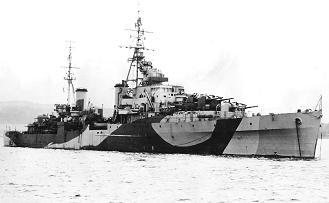
HMS
Bellona (NavyPhotos)
|
BELLONA
|
Fairfield
|
29.
9 42
|
RNZN
1948-56. Scrapped 1959
|
|
BLACK
PRINCE
|
Harland & Wolff
|
27.
8.42
|
RNZN
1948. Scrapped 1962
|
|
DIADEM
|
Hawthorn Leslie
|
28.
8.42
|
Transferred to Pakistan 1956
|
|
ROYALIST
|
Scotts
|
30
5. 42
|
RNZN
1956
|
|
SPARTAN
|
Vickers Barrow
|
27.8.42
|
Lost
29th January 1944
|
Particulars
as Designed
|
|
DIDO
Class
|
Improved DIDO Class
|
|
Displacement :
|
5,450 tons
|
5,770 tons
|
|
Armament
|
5
Twin 5-25in
(Except
* see above)
|
4
Twin 5.25in
|
|
|
2
Triple 21in Torpedo Tubes
|
2
Triple Torpedo Tubes
|
|
Length
|
512
feet
|
512
feet
|
|
Beam
|
50
feet 6 inches
|
50
feet 6 inches
|
|
Draught
|
14
feet
|
14
feet 9 inches
|
|
Machinery
|
2
Shafts: Turbines 62,000 SHP
|
2
shafts :Turbines 62,000 SHP
|
|
Speed
|
33
Knots
|
33
knots
|
|
Armour
|
Decks, Machinery & Armament
|
Decks, Machinery and Armament
|
|
Complement
|
550
|
530
|
Many
additional Close Range 20mm mountings were fitted
during build and during refit In service. Three
ships had Q Turret forward removed and replaced by
this type of weapon. By 1947 six of the Class had
been placed in Reserve and one put on the Disposal
List. Ships remaining in service had all been
Paid-off by 1956, except HMS BLACK PRINCE
transferred to the RNZN which remained in commission
until 1961.HMS DIADEM was sold to Pakistan and
renamed BABAR after a refit paid by US funds.
C O L O N Y O R
F I J I C L A S S E S
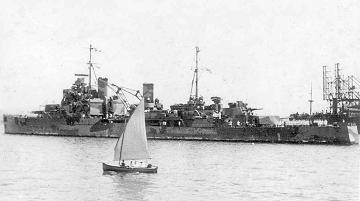
HMS Fiji (NP/Bruce
Constable)
G e n e r a l I n f o r m a
t i o n
The first five ships of the FIJI Class were ordered
under the 1937 Estimates and were followed by
another four in the Programme for 1938. Their basic
design evolved from the earlier SOUTHAMPTON Class of
heavy cruiser. However war experience showed the
need for a much greater anti-aircraft defence and
the main armament was changed after they entered
service, except for ships which had been lost. Ships
built to the new design were known as Modified FIJI
Class Cruisers.
Original
FIJI Class
|
Build Programme
|
Name
|
Builder
|
Launched
|
Completed
|
Remarks
|
|
1937
|
FIJI
|
John
Brown
|
31.
5.39
|
5
.40
|
Lost
by air attack off Crete 22. 5.41
|
|
|
KENYA
*
|
Stephens, Govan
|
18.
8.39
|
8.40
|
Scrapped Faslane 10.62
|
|
|
MAURITIUS
|
Swan
Hunter
|
19.
7.39
|
12.40
|
Scrapped Rosyth 1965
|
|
|
NIGERIA
*
|
Vickers,Tyne
|
18.
7 39
|
9.40.
|
Transferred to Indian Navy as MYSORE 1967.
|
|
|
TRINIDAD
|
Devonport Dyd
|
21.
3.40
|
10.41
|
Completion delayed by air raid damage.
Sunk in Barents Sea by own forces after
damage in air attacks.
|
|
1938
|
GAMBIA*
|
Swan
Hunter
|
30.11.40
|
2.42
|
Scrapped Rosyth 1969
|
|
|
JAMAICA
*
|
Vickers, Barrow
|
16.11.40
|
6.42
|
Scrapped Dalmuir 1960
|
|
1939
|
BERMUDA*
|
John
Brown
|
11.
9.41
|
8.42
|
Scrapped 1965
|
*
Ships converted to Modified design during service.
Modified
FIJI Class
|
1938
|
CEYLON
|
John
Brown
|
30.
7.42
|
7.43
|
Sold
to Peru 1959
|
|
|
UGANDA
|
Vickers,Tyne
|
7.
8.41
|
1.43
|
Presented to Canada 1944. Renamed QUEBEC
in 1952
|
|
1939
|
NEWFOUNDLAND
|
Swan
Hunter
|
19.12.41
|
12.42
|
Sold
to Peru 1959
|
The original design incorporating four triple 6in
turrets as main armament was changed to three triple
turrets during service by removal of X turret.
The facilities for carrying three seaplanes were
also removed after 1942 when experience in war had
shown them to be of limited value.
COLONY Class cruisers displaced 8,000 tons as
originally designed but increased due to changes
made during and after WW2. They were 555 feet 6
inches in overall length with a beam of 62 feet and
a mean draught of 16 feet. Main armament was
originally 4 triple 6in turrets and four twin 4in
secondary armament plus close range 20mm guns. The
number of these was increased during WW2 and was not
the same in all ships. After 1945 the close range
20mm weapons were replaced by 40mm Bofor type
mountings. The original design included a pair of
21in Torpedo Tube mountings but these were removed
in the Modified design. Four propellers driven by
steam turbines with shaft horsepower of 72,500 gave
a speed of 29 knots in service. Deck and side armour
protection was provided as well as that for the
armament equipment. The designed Complement was 750
but this increased significantly when radar and
additional weapon equipment was installed.
Ships of this Class were extensively deployed both
at Horns and overseas during WW2 as is shown by
their Battle Honours. Two of the Class were lost in
action during WW2. HMS FIJI was sunk after air
attacks during the defence of Crete in May 1941 .HMS
TRINIDAD had been damaged by one of her own
torpedoes which had malfunctioned after an action
against German destroyers in defence of a Russian
convoy. Following temporary repair in a North
Russian port, during passage to UK she sustained
further major damage in air attacks and had to be
sunk boy own forces
M
I N O T A U R O
R S W I F T S U R E C
L A S S
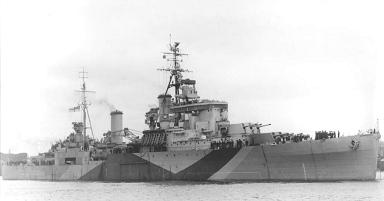
HMS
Swiftsure (NavyPhotos)
General
Information
This
Class of cruiser was a modification of the improved
design of the later FIJI Class which were completed
with only three triple 6in turrets as dual purpose
main armament for surface or anti-aircraft use. Six
ship were ordered in 1941 and a further two the next
year, but only six were completed.
The
displacement of the first six ships was 8,800 tons,
increased to 15,280 tons in the last two. The
overall length was 555 feet in the first six with a
beam of 64 feet and draught of 17 feet. In the last
two ships these were 650 feet x 75 feet x 24
feet (full load).
The
main armament comprised three triple 6in turrets,
two mounted forward and one aft. Fit of an
additional twin 4in AA mounting to increase the
defence against air attacks gave a secondary
armament of five twin 4in mountings. The first six
ships had four quadruple 2Pdr mountings and six 40
mm single mountings. The Close range AA defence in
the last two was significantly increased by having
ten twin 40mm mountings and 16 twin 20mm mountings
in the final design. Four sets of quadruple torpedo
tubes were provided in place of the two triple
mountings in the earlier design. No provision was
made for any aircraft..
Main
Propulsion machinery in the first six ships
comprised 4 geared turbines with 72,500 SHP driving
four shafts to give a designed speed of 32 knots, In
the last two ships the turbines were up-rated to
100,000 SHP giving the same speed to a larger ship.
War
complement in the first batch was about 1,000 and in
the last two ships over 1,200 because of the
increased equipment fit, especially for manning and
support of weapon equipment.
Extensive
radar equipment was fitted to provide warning of
aircraft, warning of surface ships or land and for
fire control of main, secondary and close range
armament.
The
ships of this Class were :
|
Ship
|
Builder
|
Launched
|
Completed
|
Notes
|
|
SWIFTSURE
|
Vickers, Tyne
|
4/2/43
|
22/6/44
|
Scrapped 17/10/62
|
|
ONTARIO
(RCN)
|
Harland & Wolff
|
29/7/43
|
25/25/45
|
Ex
MINOTAUR Scrapped 19/11/60
|
|
*TIGER
|
Clyde
|
25/10/45
|
18/3/59
|
Ex
BELLEROPHON. Post war redesign
|
|
*LION
|
Scotts, Greenock. Completed by Swan Hunter
|
2/9/44
|
20//7/60
|
Ex
DEFENCE.
Post
war redesign.
|
|
SUPERB
|
Swan
Hunter
|
31/8/43
|
16/11/45
|
Scrapped 8/8/60
|
|
BELLERPHON
|
Vickers, Tyne
|
not
launched
|
-
|
Ex
TIGER (i) 1945, Ex BLAKE(ii) 1944.
Cancelled 3/46
|
|
*BLAKE
|
Fairfield, Govan
|
20/12/45
|
8/3/61
|
Ex
TIGER 1944
|
|
HAWKE
|
Portsmouth Dyd
|
not
launched
|
-
|
Cancelled 3/46
|
Notes: *Work on these three ships was suspended
after 1946 and in 1954 build recommenced to
a revised design.
HMS
TIGER was first deployed as a cruiser between 1959
and 1966 and
then converted
for
use as a Helicopter cruiser for amphibious
operations. She paid-off
in 1978.
HMS
LION was deployed as a cruiser until 1972 when
placed in Reserve.
HMS
BLAKE was deployed as a cruiser till 1964 and
converted for use as
a Helicopter
Cruiser
in which role she served until paying off in 1979.
C
R U I S E R M I N E L A Y E R S
A
B D I E L C L A S
S F A S T M I N
E L A Y E R S
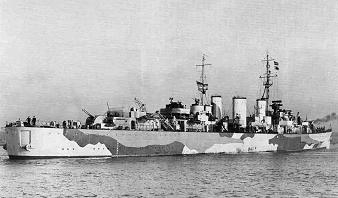
HMS
Abdiel (NP/Bob Hanley)
General
Information
Four
ships of this type were ordered under the 1938
Estimates and described as LATONA Class Cruiser
Minelayers. Since the loss of HMS LATONA they have
generally been called ABDIEL Class Fast Minelayers
and were designed for speedy minelaying operations
in hostile waters. These ships ware the fastest
cruisers in the Royal Navy at the time of their
build and had a designed speed of 40 knots but this
was not attained in service. A second batch of two
ships was ordered under War Estimates.
|
Build
Programme
|
Ship
|
Builder
|
Launched
|
Completion
|
Disposal
|
|
1938
|
MANXMAN
|
Alex.
Stephen
|
05/09/40
|
20/6/41
|
Scrapped
10/72
|
|
|
ABDIEL
|
J
S White
|
23/04/40
|
15/04/41
|
Mined
10/09/43
|
|
|
LATONA
|
Thornycroft
|
20/08/40
|
04/05/41
|
Air
attack 25/10/41
|
|
|
WELSHMAN
|
Hawthorn
Leslie
|
04/09/40
|
25/08/41
|
Torpedoed
01/02/43
|
|
1942
|
APOLLO
|
Hawthorn
Leslie
|
05/04/43
|
12/02/44
|
Scrapped
28/11/62
|
|
|
ARIADNE
|
Alex.
Stephen
|
16/02/43
|
09/10/43
|
Scrapped
14/02/65
|
ABDIEL
Class minelayers displaced 2,650 tons and had an
overall length of 418 feet, a beam of 40 feet and a
mean draught of 11 feet 2 inches. During build the
first batch of four ships ware fitted with three
twin 4.7in mountings for surface defence. After 1942
these mountings were replaced by twin 4in HA to
provide defence against air attack but still
retaining a surface capability. The last two ships
were fitted with two twin 4in HA mountings during
build, one mounted forward and the other aft. All
ships had radar fire control of the main armament.
Progressive improvements in Close range AA weapons
were made in all ships during war service. Their
minelaying capacity was 160 mines.
Two
propellers driven by steam turbines with shaft
horsepower of 72,000 gave a speed of over 35 knots
in service. Endurance at full speed was about 1,000
miles. The original Complement was about 300 in war
but reduced in peace to about 250.
During
WW2 the ABDIEL Class Fast Minelayers carried out
extensive minelaying in many parts of the world.
However, between 1941 and 1943 they were frequently
used for other duties which required the use of a
ship capable of sustained periods at high speed. In
particular they were in demand for high priority
requirements such as the transport of personnel and
stores to Crete, Malta, Cyprus and Tobruk. Their
spacious design and high speed made them very
successful but also vulnerable, especially to air
attack.
Three
ABDIEL Class Fast Minelayers were lost. HMS WELSHMAN
was the only one in use at the time for a minelaying
operation. She was returning to Alexandria from a
minelay in the central Mediterranean when torpedoed
by U617 off Crete. HMS ABDIEL sank after she
detonated a mine at Taranto during the allied
occupation in September 1943, and HMS LATONA
was sunk in air attack during support of the Tobruk
garrison in October 1941 and had never been deployed
on a minelaying operation. The remaining three
ships survived the war and were then reduced to
Reserve. HMS MANXMAN was seriously damaged when
torpedoed by U375 during passage to Gibraltar from
Algiers in December 1943- Major repair kept the ship
out of service until May 1945.
After
VJ Day the remaining ships were deployed in the
Pacific to carry personnel, mail and stores in
support of repatriation and other British Pacific
Fleet activities. They returned to UK in 1946 and
were placed in Reserve. HMS APOLLO was brought
forward for Home Fleet service in 1951 and after
1954 used as Flagship. She went on the Disposal List
in 1961 and was broken up the next year. HMS MANXMAN
came out of Reserve in 1951 and after Fleet service
underwent conversion for use as a Minesweeper
Support Ship in 1963. Structural changes made to
provide workshops and improved accommodation and the
removal of two boiler rooms reduced speed to 26
knots. She was deployed at Singapore from 1963 until
1968. On return again altered for use as a training
ship for engineer officers. After damage by fire in
1969 she want on the Disposal List and scrapped
three years later. HMS ARIADNE refitted in 1951/52
but stayed in Reserve till 1962 when placed on the
Disposal List and scrapped in 1965.
|